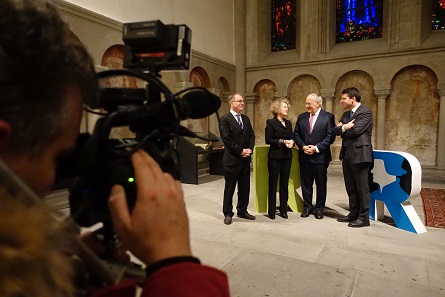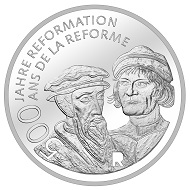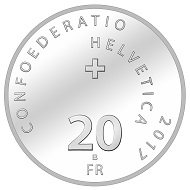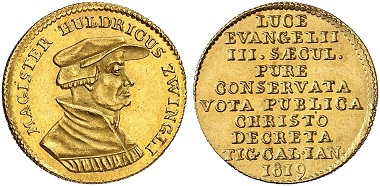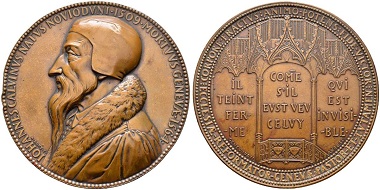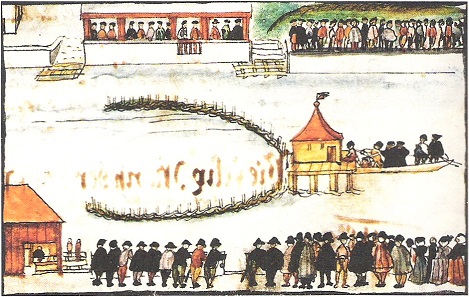by Ursula Kampmann
translated by Christina Schlögl
January 26, 2017 – It was cold, bitingly cold, when Federal councilor Johann Schneider-Amman, head of the Federal Department of Economic Affairs, Education and Research, presented the president of the Federation of Swiss Protestant Churches Gottfried Locher with the first official exemplar of the Swiss Reformation coin after dusk on 5 January 2017. It was exceptionally cold because the ceremony did not take place inside the Grossmünster but rather in front of it.
The actual media conference was held inside the warm church. From left to right: Michel Müller (President of the church in Zurich), Corine Mauch (Mayor of Zurich), Johann Schneider-Amman (Federal Councilor) and Gottfried Locher (President of the FSPC). Photo: UK.
If anyone wants to interpret this as an allusion to the Protestant willingness to sacrifice or to the contempt of corporeality, they are wrong. Actually, a sort of spiritual, artistic lights and sounds show had been organised on occasion of the Reformation year and its premiere should have coincided with the opening ceremony. However no one on the organisation board had taken into consideration that even in times of climate change, winter in Switzerland can be quite cold after all.
Johann Schneider-Amman presents Gottfried Locher with the commemorative coin for the Reformation year. Photo: UK.
Therefore the unveiling of the coin’s effigy, as well as the presentation was very quick, brief and arid, which is a shame, since the Swiss Reformation with Zwingli and Calvin was at least as defining for the Reformation as the German version with Martin Luther. Moreover this new commemorative coin stands in a centuries-old tradition of numismatic celebrations of the start of the Reformation.
The new commemorative coin: CHF 20 / 0.835 silver / 20 g / 33 mm / mintage: uncirculated 30,000 (2,000 of them in an attractive folder), proof 5,000.
The Swiss commemorative coin depicts Calvin on the left and Zwingli on the right. Zwingli is slightly behind Calvin, which is not historically accurate, since Huldrych Zwingli (1484-1531) inspired the start of the Reformation in 1522 – not by posting theses though, but by eating sausages.
Zurich. Ducat 1819 celebrating the 300-year anniversary of the Reformation. From the auction Künker 283 (2016), 5938.
The “Affair of the Sausages” took place on 5 March 1522, which was Ash Wednesday! Christoph Froschauer was a supporter of the Reformation and demonstrated against the non-biblical Lenten commandment of the Catholic Church by eating thin slices of smoked sausage on “Fasnachtskiechli” (a regional type of pastry). The Grand Council of Zurich investigated the case. Zwingli, who had not been part of the demonstration himself, defended his publisher Froschauer in a document that simultaneously brought all non-biblical commandments of the church into question. The Great Council of Zurich followed his line of argumentation and close to a year later, all Catholic Lenten commandments were abolished by means of the First Zurich Disputation. Surely however, this is not the time and place to retrace all steps of the Swiss Reformation. Let’s just put it like this: From there on, Zwingli’s ideas spread from Zurich to a number of other Swiss cities.
Zurich. Bronze medal 1835 by A. Bovy. From the auction Sincona 29 (2016), 2390.
John Calvin (1509-1564) had been the undisputed reformer of the city of Geneva since 1541.
He is considered the founder of Calvinism, probably the strictest interpretation of the bible which demanded a precedence of the spiritual before the mundane. This was the reason for the repeated disputes between the Great Council of Geneva and Calvin. This is why the Peace of Augsburg did not apply to the followers of Calvinism. And this is why a lot of Calvinists fled to the New World, where their way of interpreting the bible became a foundation of the United States of America.
Felix Manz is drowned in the Limmat River. Image from the beginning of the 17th century.
There is one person missing on this coin, which is a shame. The start of the Zurich Reformation was followed by the commencement of the Anabaptist movement around Felix Manz and Konrad Grebel. The baptists did not only demand adult baptism. They thought that all this state-organised reforming was not going far enough. They wanted to burn the paintings, tear down the churches (or at least clean them of all the Catholic rubbish) and stop every kind of constraint by the state. The Great Council of Zurich thus held a disputation in which the baptists were defeated. This came to no surprise to anyone. The baptists were forced to renounce their faith or emigrate. Felix Manz kept on preaching anyway. This earned him the death sentence in 1527. He was drowned – a particularly disgraceful manner of death.
He was not the only reformer that died a violent death. Zwingli was taken prisoner after the battle at Kappel. The (Catholic) people of Central Switzerland, who had been fighting the Zurich attempts at expansion, killed him, quartered his corpse and burnt the remains in order to scatter his ashes into the wind.
Only John Calvin, after a long illness, died in his own bed. (If you would like to believe Catholic rumors, he died corroded by ulcers and under tremendous pain, just like the arch-scoundrel Herod.) Calvin, too, was not free of guilt. He had been contributing to the execution of Servetius for instance, because he had not shared Calvin’s perceptions of the Holy Trinity.
When celebrating the start of the Reformation today, we should remember that even in Christianity, there were times when it was not self-evident to let theological dissidents survive. The Reformation has spread its ideology on streams of blood. Just like the Catholic Church had done for centuries and should continue to do after the Reformation.
Incidentally, with the Council of Trent, it reformed itself even more radically than one of the first reformers would ever have thought possible…
If the Reformation jubilee will make only a few people aware that religious radicalism never leads to good results, this jubilee will have truly been worthwhile.
You can directly order the commemorative coin at the Swissmint.
The Reformation-truck is touring through 19 European countries and stops at the most significant sights of the Reformation. Here you can check if your city is included in the tour.
Wikipedia offers an excellent article on Huldrych Zwingli.
And John Calvin has his own webpage.
Swiss tourism advertises with these great representatives of their country.
Felix Manz is not represented as often, but at least the NZZ dedicated this interesting article to him – in German.




